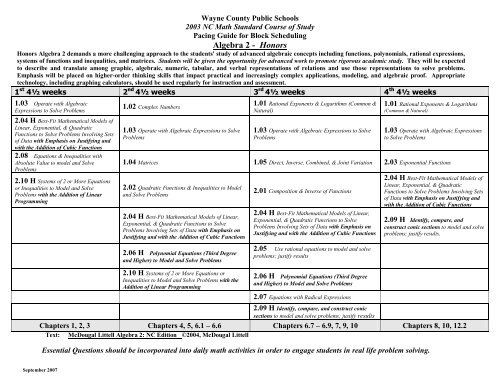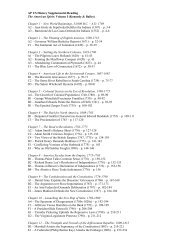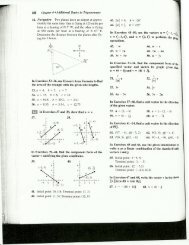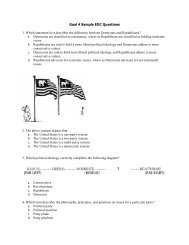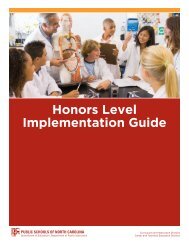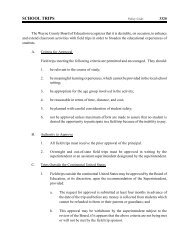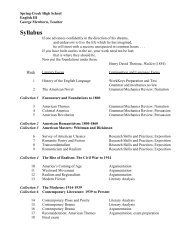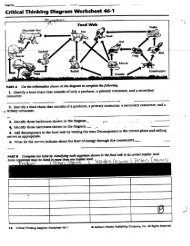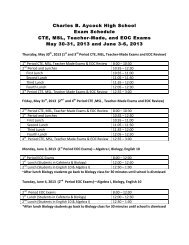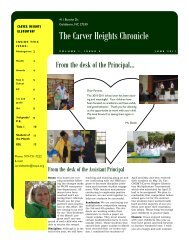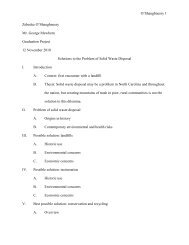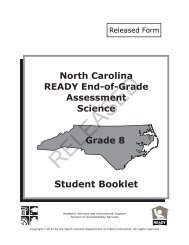Algebra 2 Honors Pacing Guide - Wayne County Public Schools
Algebra 2 Honors Pacing Guide - Wayne County Public Schools
Algebra 2 Honors Pacing Guide - Wayne County Public Schools
- No tags were found...
Create successful ePaper yourself
Turn your PDF publications into a flip-book with our unique Google optimized e-Paper software.
<strong>Wayne</strong> <strong>County</strong> <strong>Public</strong> <strong>Schools</strong>2003 NC Math Standard Course of Study<strong>Pacing</strong> <strong>Guide</strong> for Block Scheduling<strong>Algebra</strong> 2 - <strong>Honors</strong><strong>Honors</strong> <strong>Algebra</strong> 2 demands a more challenging approach to the students' study of advanced algebraic concepts including functions, polynomials, rational expressions,systems of functions and inequalities, and matrices. Students will be given the opportunity for advanced work to promote rigorous academic study. They will be expectedto describe and translate among graphic, algebraic, numeric, tabular, and verbal representations of relations and use those representations to solve problems.Emphasis will be placed on higher-order thinking skills that impact practical and increasingly complex applications, modeling, and algebraic proof. Appropriatetechnology, including graphing calculators, should be used regularly for instruction and assessment.1 st 4½ weeks 2 nd 4½ weeks 3 rd 4½ weeks 4 th 4½ weeks1.03 Operate with <strong>Algebra</strong>icExpressions to Solve Problems2.04 H Best-Fit Mathematical Models ofLinear, Exponential, & QuadraticFunctions to Solve Problems Involving Setsof Data with Emphasis on Justifying andwith the Addition of Cubic Functions2.08 Equations & Inequalities withAbsolute Value to model and SolveProblems2.10 H Systems of 2 or More Equationsor Inequalities to Model and SolveProblems with the Addition of LinearProgramming1.02 Complex Numbers1.03 Operate with <strong>Algebra</strong>ic Expressions to SolveProblems1.01 Rational Exponents & Logarithms (Common &Natural)1.03 Operate with <strong>Algebra</strong>ic Expressions to SolveProblems1.01 Rational Exponents & Logarithms(Common & Natural)1.03 Operate with <strong>Algebra</strong>ic Expressionsto Solve Problems1.04 Matrices 1.05 Direct, Inverse, Combined, & Joint Variation 2.03 Exponential Functions2.02 Quadratic Functions & Inequalities to Modeland Solve Problems2.04 H Best-Fit Mathematical Models of Linear,Exponential, & Quadratic Functions to SolveProblems Involving Sets of Data with Emphasis onJustifying and with the Addition of Cubic Functions2.01 Composition & Inverse of Functions2.04 H Best-Fit Mathematical Models of Linear,Exponential, & Quadratic Functions to SolveProblems Involving Sets of Data with Emphasis onJustifying and with the Addition of Cubic Functions2.04 H Best-Fit Mathematical Models ofLinear, Exponential, & QuadraticFunctions to Solve Problems Involving Setsof Data with Emphasis on Justifying andwith the Addition of Cubic Functions2.09 H Identify, compare, andconstruct conic sections to model and solveproblems; justify results.2.06 H Polynomial Equations (Third Degreeand Higher) to Model and Solve Problems2.05 Use rational equations to model and solveproblems; justify results2.10 H Systems of 2 or More Equations orInequalities to Model and Solve Problems with theAddition of Linear Programming2.06 H Polynomial Equations (Third Degreeand Higher) to Model and Solve Problems2.07 Equations with Radical Expressions2.09 H Identify, compare, and construct conicsections to model and solve problems; justify resultsChapters 1, 2, 3 Chapters 4, 5, 6.1 – 6.6 Chapters 6.7 – 6.9, 7, 9, 10 Chapters 8, 10, 12.2Text: McDougal Littell <strong>Algebra</strong> 2: NC Edition ©2004, McDougal LittellEssential Questions should be incorporated into daily math activities in order to engage students in real life problem solving.September 2007
<strong>Wayne</strong> <strong>County</strong> <strong>Public</strong> <strong>Schools</strong>Suggested Timetable for <strong>Algebra</strong> 2 <strong>Honors</strong>2 nd Nine Weeks Essential Questions should be incorporated into daily math activities in order to engage students in real life problem solving. Text: McDougal Littell <strong>Algebra</strong> 2: NC Edition, ©2004Objective Chapter Section Days for Instruction2.06 H Polynomial Equations(Third Degree or Higher)1.03 Operate with <strong>Algebra</strong>ic ExpressionsChapter 6 Polynomials and PolynomialFunctions6.7, 6.8 Fundamental Theorem of <strong>Algebra</strong>; AnalyzingGraphs of Polynomial Functions2 days2.04 H Best-Fit Mathematical Models;Justify; Include Cubic Functions6.9 Modeling2 days1.01 Rational Exponents and Logarithms2.07 Radical Expression1.03 Operate with <strong>Algebra</strong>ic ExpressionChapter 7 Powers, Roots, & Radicals7.1 nth Roots; Rational Exponents7.2 Properties of Rational Exponents1 day1 day2.01 Composition and Inverse ofFunctions7.3 Power Functions; Function Operations7.4 Inverse Functions1 day2 days2.06H Polynomial Equations(Third Degree or Higher)2.07 Radical Expressions7.5 Square Root and Cube Root Functions2 days2.07 Radical Expressions7.6 Solving Radical Equations2 days1.05 Direct, Inverse, Combined, andJoint Variation2.05 Rational EquationsChapter 9 Rational Equations andFunctions9.1 Inverse & Joint Variation9.2, 9.3 Graphing Rational Functions1 day2 days1.03 Operate with <strong>Algebra</strong>ic Expressions2.05 Rational Equations2.09 H Conic Sections1.03 Operate with <strong>Algebra</strong>ic ExpressionsChapter 10 Quadratic Relations & ConicSections9.4 x, ÷, Rational Expressions9.5 +, - Rational Expressions; Complex Fractions9.6 Solving Rational Equations10.1-10.2 Distance & Midpoint; Parabolas10.3 Circles10.4 Ellipses10.5 Hyperbolas10.6 Graphing & Classifying Conics10.7 Solving Quadratic Systems2 days2 days1 day (21 days)1 day1 day1 day1 day1 day1 day2.03 Exponential Functions1.01 Rational Exponents and Logarithms2.03 Exponential Functions2.04 H Best-Fit Mathematical Models;Justify; Include Cubic FunctionsChapter 8 Exponential and LogarithmicFunctions8.1, 8.2 Exponential Growth & Decay8.3 e8.4 Logarithmic Functions8.5 Properties of Logarithms8.6 Solve Exponential & Logarithmic Equations8.7 ModelingChapter 12 Combinations & the12.2 Combinations & the Binomial Theorem1.03 <strong>Algebra</strong>ic ExpressionsBinominal TheoremMidterm 1 day Final Exams 2 days The remaining days are for review and assessment.1 day1 day1 day2 days2 days2 days1 day(16 days)September 2007
Number & OperationsThe learner will perform operationswith complex numbers, matrices, andpolynomials.1.01 Simplify and performoperations with rationalexponents and logarithms(common and natural) to solveproblems.1.02 Define and compute withcomplex numbers.1.03 Operate with algebraicexpressions (polynomial,rational, complex fractions) tosolve problems.1.04 Operate with matrices tomodel and solve problems.1.05 Model and solve problemsusing direct, inverse,combined and joint variation.<strong>Wayne</strong> <strong>County</strong> <strong>Public</strong> <strong>Schools</strong><strong>Algebra</strong> 2-<strong>Honors</strong>2003 NC Math Standard Course of Study<strong>Algebra</strong>The learner will use relations and functions to solve problems.2.01 Use the composition and inverse of functions to model and solve problems; justify results.2.02 Use quadratic functions and inequalities to model and solve problems; justify results.a) Solve using tables, graphs, and algebraic properties.b) Interpret the constants and coefficients in the context of the problem.2.03 Use exponential functions to model and solve problems; justify results.a) Solve using tables, graphs, and algebraic properties.b) Interpret the constants, coefficients, and bases in the context of the problem.2.04 H Create, justify, and use best-fit mathematical models of linear, exponential, quadratic, and cubic functions tosolve problems involving sets of data.a) Interpret the constants, coefficients, and bases in the context of the data.b) Check the model for goodness-of-fit and use the model, where appropriate, to draw conclusions or make predictions.2.05 Use rational equations to model and solve problems; justify results.a) Solve using tables, graphs, and algebraic properties.b) Interpret the constants and coefficients in the context of the problem.c) Identify the asymptotes and intercepts graphically and algebraically.2.06 H Use polynomial equations (third degree and higher) to model and solve problems.a) Solve using tables and graphs.b) Interpret constants and coefficients in the context of the problem.2.07 Use equations with radical expressions to model and solve problems; justify results.a) Solve using tables, graphs, and algebraic properties.b) Interpret the degree, constants, and coefficients in the context of the problem.2.08 Use equations and inequalities with absolute value to model and solve problems; justify results.a) Solve using tables, graphs, and algebraic properties.b) Interpret the constants and coefficients in the context of the problem.2.09 H Identify, compare, and construct the conic sections to model and solve problems; justify results.H a) Precisely describe parabolas and circles algebraically according to definitions, characteristics, andconstituent parts.a) Interpret the constants and coefficients of parabolas and circles in the context of the problem.H c) Identify and distinguish among the conic sections using tables, graphs, and algebraic properties.2.10 H Use systems of two or more equations or inequalities to model and solve problems; justify results. Solve usingtables, graphs, matrix operations, algebraic properties, and linear programming..The <strong>Honors</strong> (H) version of <strong>Algebra</strong> 2 includes the goals and objectives from the standard version plus: creating, justifying and using best-fit mathematical models ofcubic functions to solve problems involving sets of data; using polynomial equations (third degree or higher) to model and solve problems; using conic sections tomodel and solve problems; and using linear programming.September 2007


